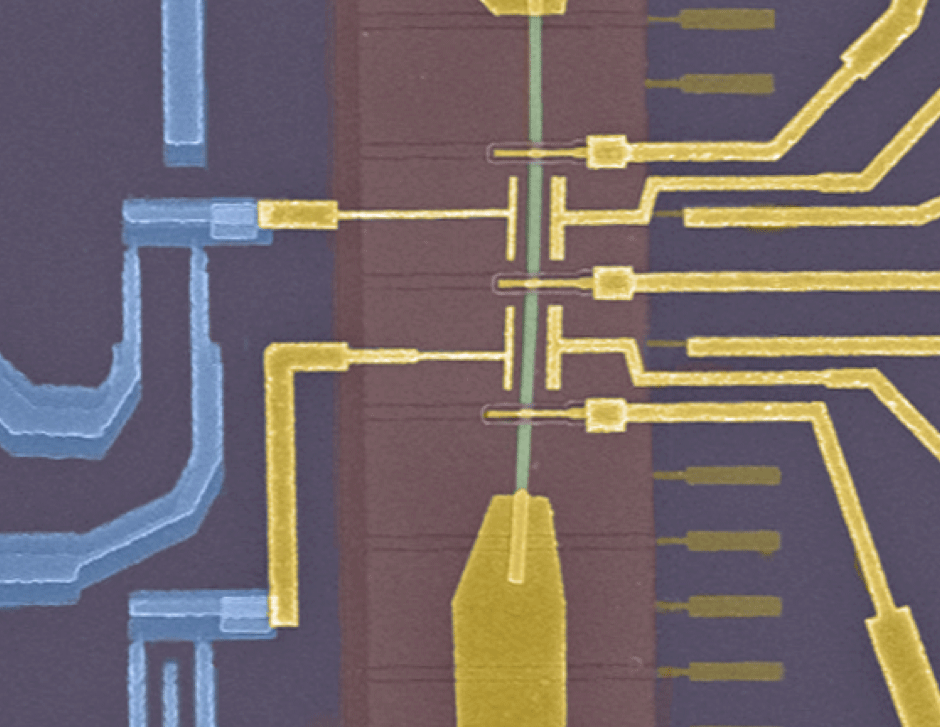Meetings: Majoranas in Majorca
A Majorana particle is something of an oxymoron: a particle that contradicts itself by being its own antiparticle. The term was coined for fundamental particles and might apply to neutrinos. But condensed-matter physicists have their own versions of Majoranas in the form of collective electronic states, or quasiparticles, in a superconducting material. These so-called topological states are robust against environmental noise, making them attractive for quantum computing. Over the past five years, evidence has popped up for condensed-matter Majoranas at the ends of nanowires, in chains of single atoms, and on the edges of materials known as topological insulators. But have physicists actually detected Majoranas? That question and others were tackled by 150 scientists in May at the Majorana States in Condensed Matter meeting in Majorca, Spain.
The conference organizers, led by Ramón Aguado from the Institute of Materials Science in Madrid and the Spanish Research Council, attracted researchers from around the world with a simple formula: “Majoranas on Majorca in the month of May” (more effective than, say, “Fermions in Fairbanks for February”). Aguado says that the goal was to bring together different communities that approach Majoranas in unique ways. And true to the Spanish locale, the meeting offered a tapas-style sampling of the many systems in which Majorana states are thought to exist. Laurens Molenkamp of the University of Würzburg, Germany, kicked off the meeting with a talk about observed signatures of Majoranas in a topological insulator that has been induced to superconduct. Stanford University’s Shoucheng Zhang presented recent experimental evidence for a “chiral Majorana fermion,” which relies on a mixture of the quantum anomalous Hall effect and superconductivity. And Ali Yazdani of Princeton University spoke about the detection of a potentially new Majorana signal from spin chains, which consist of a sprinkling of magnetic atoms on a superconductor surface.
However, of all the Majorana platforms, the one that has attracted the most excitement is the system based on nanowires. In 2010, theorists predicted that a semiconducting nanowire in the presence of a superconductor and a magnetic field should host a pair of Majorana states—one at each end of the wire. Just two years later, a group led by Leo Kouwenhoven from QuTech in Delft, Netherlands, reported the first solid hints of Majoranas in indium antimonide wires that were a hundred nanometers wide and about a micrometer long. Shortly after, Charlie Marcus from the University of Copenhagen, Denmark, and his team found the same signatures in indium arsenide nanowires. Banking on the future of so-called topological quantum computing, Microsoft hired both Kouwenhoven and Marcus in November of 2016 to try to create quantum bits with Majorana-hosting nanowires.
What makes Majoranas so tantalizing for quantum computing is that they are described by non-Abelian statistics, which means swapping two Majoranas can alter the ground state of the system—depending on how the swap occurs. This unique feature allows quantum information to be stored through a process called “braiding.” As an example, imagine Majorana A on the left and Majorana B on the right. Swapping A with B through a clockwise rotation could correspond to a zero. In contrast, a counterclockwise rotation would give a one. The information stored in these rotations (the values zero or one) is robust because even if environmental noise affects one particle’s quantum state, it’s not likely to alter the relative positions of particles A and B.
Braiding may sound wild, but if physicists can make it work, they’d be on the path to building a so-called topological quantum computer that could require less error correction than standard quantum computers. This promise has invigorated the condensed-matter community, not to mention given it a new aura of cool in the public eye. Jens Paaske from the University of Copenhagen says he can now give talks to high school students. “I tell them that tying knots inside a crystal may one day result in a computer more powerful than anything we have now,” he says.
But some physicists caution that this excitement might be getting ahead of reality. That’s because it’s not 100% clear that Majoranas have been discovered. Among several smoking gun signals for the states, the standout is the so-called zero-bias conductance peak, which has been observed in both nanowires and spin chains. As the system’s voltage is tuned to zero, researchers observe that the current actually spikes up. A Majorana sitting on the end of the nanowire or the spin chain could explain this zero-bias current, but so could other “trivial” states. Experimentalists, like Kouwenhoven and Marcus, have improved their systems, making the zero-bias signature clearer. But that doesn’t remove all the doubts, says Jay Sau from the University of Maryland, College Park, who added “Some people don’t want to think about zero-bias conductance anymore; they just want to start braiding.”
Marcus agrees with Sau that the job of verifying the presence of Majoranas must continue, but he also believes that “it is time to try the next step.” His group is starting to work on nanowire networks etched into substrates, in which Majoranas could be braided around each other and then brought together, or “fused,” to read out their value. For their own braiding architecture, Kouwenhoven’s team is growing nanowires in crossing patterns that look like little hashtags. Kouwenhoven is betting that within a year they can demonstrate a Majorana qubit that can perform non-Abelian computation. “I’m pretty optimistic,” he says. That optimism is contagious: “Maybe in two to three years, another conference like this would be a good place to announce braiding of Majoranas!” says Aguado.
–Michael Schirber
Michael Schirber is a Corresponding Editor for Physics based in Lyon, France.





